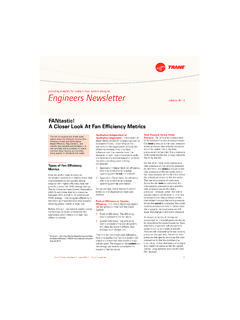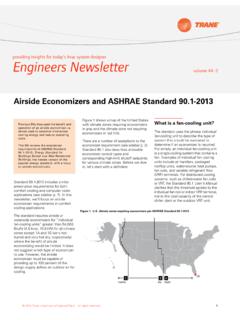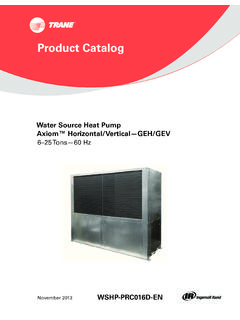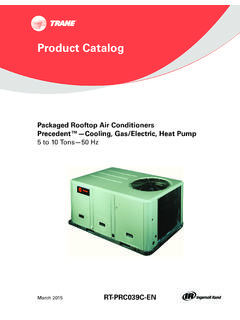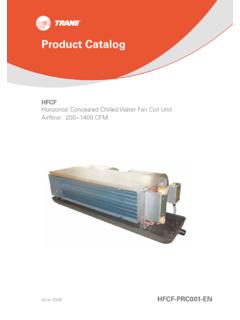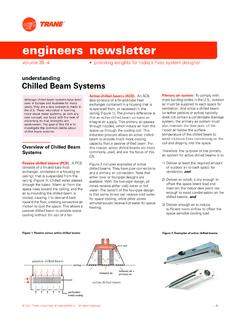Transcription of Chilled-Water System Decisions
1 providing insights for today 's hvac System designer Engineers Newsletter volume 47 3. impacts of Chilled-Water System Design Decisions Primary-secondary System bypass This Engineers Newsletter walks through a number of design Decisions , with Bypass line sizing sizing. The premise of a primary- discussion and examples to explain how secondary System is to hydraulically This seemingly simple decision can have and why those Decisions are made. separate (decouple) the primary (chiller). significant consequences if not done flow from the secondary ( System ) flow. correctly. This decoupling prevents the operating In a primary-secondary System , the pressures of chiller pumps from impacting While designing a Chilled-Water bypass pipe should be the same the operating pressures of the System System , a myriad of Decisions must diameter as the pipe going into the pumps.
2 This is accomplished by installing be made. Experienced engineers largest chiller. Its length should be a bypass line with a small pressure drop. often make these Decisions about 8-10 pipe diameters long or The bypass allows water to flow in either "automatically" as they have in the have an equivalent pressure drop. direction and is used to indicate chiller and past, based on what they have learned from experience. today , all In a variable primary flow (VPF) primary pump sequencing in this System engineers likely use an internet System , the bypass line should be arrangement (Figure 1). search engine to get direction, but sized for the largest minimum flow Chillers and constant flow primary pumps when there are differing or even rate and it will have a control valve.
3 Are enabled in pairs, making the primary conflicting recommendations a The reasons behind this guidance follow. flow rate a step function. As System load decision must be made. and flow increase, the excess flow rate Common Decisions regarding (from supply to return) in the bypass line Chilled-Water System designs decreases. At the point that System flow include: rate exceeds chiller flow rate, deficit flow bypass line sizing in variable Figure 1. Primary-secondary System flow systems dynamically varying condenser primary water flow pumps number of Chilled-Water pumps to operate secondary pumps with series chillers and power VSDs consumption Chilled-Water coling coils whether to use pressure- with two-way independent control valves valves bypass line, free of restrictions, sized the same as the largest chiller's pipe, aim for a pressure drop equivalent to a pipe that is 8-10 pipe diameters long.
4 2018 Trane. All rights reserved. 1. (from return to supply) in the bypass Figure 2. Oversized bypass can allow simultaneous flow in both directions line occurs. This warm, deficit water flow increases the System supply- chiller return chiller supply water water water temperature and at some point an additional chiller and primary pump are enabled. short-circuited chiller A chiller and pump are disabled when supply water excess flow rate in the bypass line is high enough to still have excess flow after a primary pump is turned off. Therefore the maximum flow rate the bypass line ever experiences is a little short-circuited System higher than the design flow rate of the return water largest chiller.
5 Often designers wait for 10-15 percent excess flow, to ensure System System that chillers are not cycled on and off return water supply water rapidly. Therefore the bypass pipe should be sized for 110 to115 percent Much of that water continues to the Add pressure drop. A better option of the largest chiller's flow rate which chillers but some of the warm water may be to place an orifice in the line. This most designers simplify to the same (due to low pressure drop in the can simply be a plate with a hole in it. as the pipe size going into the largest bypass) flows in the deficit direction This imposes a pressure drop, but allows chiller. in the bypass line (from return to the water to flow freely in either the surplus supply).
6 Or deficit direction. In a few extreme What happens if bypass sizing is cases it has been neccessary to not right? Too little or too much As a result there is simultaneous flow in completely block off the oversized/short pressure can cause opposite directions because the bypass bypass pipe and install a properly sized line has become so large it functions like pipe of sufficient length to eliminate the Too small, pressure too high? An a tank! mixing condition. undersized bypass line can result in high fluid velocity, which in extreme The diluted (higher) System supply-water The best way to avoid issues in a conditions may cause pipe erosion, temperature results in more pumping primary-secondary System is to size the vibration and acoustic issues.
7 The high energy. The short-circuited supply water bypass line properly during the design fluid velocity can also result in high mixing with return water results in process. Simply check the drawings and enough pressure drop so that flow is reduced chiller return-water temperature. ensure that the bypass line is smaller restricted through the bypass, and This can restrict the chillers' ability to than the manifold, and the same size as may actually cause the primary and fully load. the pipe going into the largest chiller and secondary pump pressures and flow 8 to 10 equivalent pipe diameters long. If rates to affect each other. If the pipes are already installed how the pipe is less than 8 to10 pipe can the situation be improved?
8 A diameters long, using elbows to form a Too large, pressure too low? A. resolution for too low of a pressure drop "U" adds an appropriate pressure drop. benefit of an oversized bypass pipe is a is to impose a modest restriction to keep very low pressure drop, however if it's water from short-circuiting. Aim for the Variable-primary-flow System bypass too low, the water may not flow as equivalent pressure drop of a pipe that is line sizing. Conceptually a variable- intended. Figure 2 illustrates the issue: 8 to 10 pipe diameters long. primary-flow System is simpler to get Cold water leaves the chillers and right. The valve in the bypass line only flows into the chiller supply Often the first solution considered is to opens when the System flow rate manifold.
9 Add a valve. Given that the bypass line is approaches the minimum flow rate of the oversized, it's likely the additional valve A portion of that cold water flows operating chiller(s). So the bypass pipe will be big and expensive. It's also likely toward the secondary pump. and valve only need to be sized for the that at some point a well-meaning but However due to the very low largest minimum flow rate. Usually that's uninformed operator will close the valve pressure drop in the bypass, some the largest chiller's minimum flow rate. too much. Or, they might open it all the of the cold water seeks the path of However, depending on chiller way and defeat this solution. Recall that least resistance and flows through selections, the largest minimum flow the bypass line in a primary-secondary the bypass line in the excess rate might not be for the largest chiller in System should allow water to flow freely, direction.
10 The plant. Also consider the combined in either direction, as needed. minimum flow required when two Similarily in the return-water side, chillers are operating at part load, just warm return water flows in the before sequencing off one chiller. System return manifold. 2 Trane Engineers Newsletter volume 47-3 providing insights for today 's hvac System designer Table 1. Plant annualized kW/ton and percent savings compared to two-chiller base for three alternatives Should we dynamically vary Condenser the condenser water flow? Chiller Cooling water flow Condenser Tower Plant Alternative water flow control annualized Savings type tower fan rate Yes, savings are available in existing type method* kW/ton (gpm/ton).
